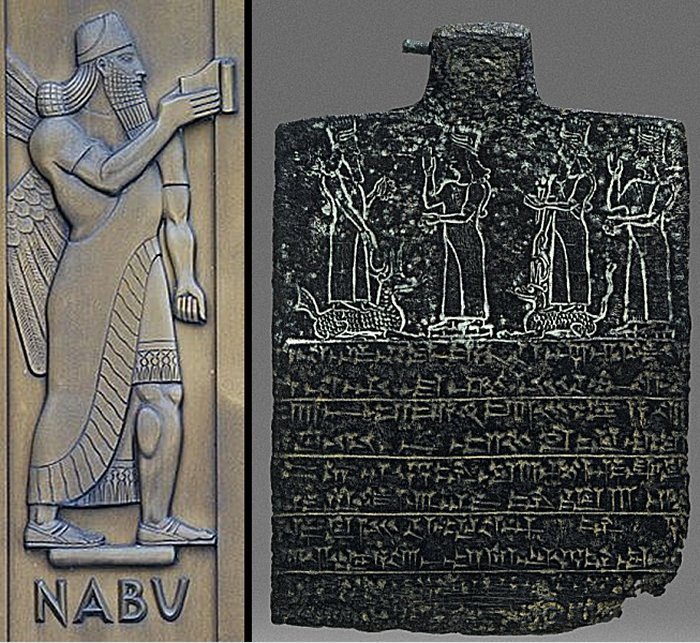Mesopotamian God Nabu Inscribed The Human Fates Determined By The Gods
A. Sutherland - AncientPages.com - Nabu was among the most prestigious Babylonian-Assyrian gods, but he earned his importance much later in the first millennium BC.
At a time, he was identified as the son of the god Marduk, the son of Enki, and the patron god of the city of Babylon.
With his consort, Tashmet ( “the lady who listens”), god Nabu shared a temple in the city of Borsippa, in which they were patron deities. Credit: Public Domain
Much earlier in the Sumerian pantheon, Nabu was known as a female deity Nisaba, patron of writing, learning, and harvest. Later as the Mesopotamian god of wisdom, patron god of literacy, scribes, knowledge, and the gods' messenger, Nabu became widely known, respected, and worshiped.
The Babylonian works included the ritual phrase "Praise be to Nabu!"
God Nabu ('A Prophet') Is Related To Ebla
His name 'Nabu' is related to the archaic Ugaritic 'Nbu,' which means a prophet, a seer, a reader of oracles. Additionally, from his name Nabu also derived the words: Nebo (in Proto-Aramic) and Nabi (in Arabic and Persian), and both have the same meaning: a prophet.
A historical look at god Nabu's life shows that he was originally a Syrian god included in the list of the gods of Ebla. This mysterious ancient city existed thousand years before the biblical time of Kings David and Solomon.
The myths of Mesopotamia mention that Nabu engraves the fate of people and the world on the 'Tablet of Destiny' that was later stolen by the evil bird god Anzu. Ancient sources indicate that before Nabu entered the Assyrian pantheon, he was known as the scribe and vizier of Marduk, who recorded all the decisions of the gods regarding humans.
Around the second millennium BC, the contemporary scribes of Ugarit and the Amorites from Syria brought Nabu's cult to Mesopotamia.
The Concept Of Fate In The Ancient World
Nabu was said to be the keeper of the tablet of fate regarding the ancient Babylonians and Assyrians. In the ancient world, many people believed in fate. Our ancestors thought that different deities predetermined their lives. Even though people had free will and thought they changed events, the outcome was always the same.
Free only allowed people to make decisions that led to their predetermined fate. For example, in Norse mythology, the Norns were goddesses who decided the fates of people and determined individuals' destinies and lifespans. Ancient Greeks have myths about the Graeae, three sisters of fate who shared one eye and one tooth.
Left: Lee Lawrie, Nabu (1939). Library of Congress John Adams Building, Washington, D.C.; Right: The figures of four deities, including Marduk, holding a necklace and standing on a dragon, and Nabu, holding a stylus, are incised above the inscription, a dedication to Nabu. Image credit: British Museum
As mentioned in another article on Ancient Pages, one can compare the Graeae with the three spinners of Destiny, the Moirai, also called the Fates, in Greek mythology. The three Moirai determined the span of human life of every mortal from birth to death. They were so powerful that no god had the right or the means to alter their decisions.
Although the Fates were the personifications of destiny, no human could blame the fates since there were times he was the only one responsible for his failures. The belief that a person could not escape certain events was widespread.
Place Of Residence And Cult Center Of Nabu
Nabu resided in his temple E-zida in the vicinity of Borsippa (Babylon's lesser sister city), considered by modern scholars as a religious edifice in honor of this god. Each New Year, his statue was moved to Babylon so Nabu could pay his profound respect to his father.
During the celebrations (the Akitu Festival) that lasted for twelve days and were closely related to the god Marduk, Nabu also played an important role.
His popularity increased primarily during the Old Babylonian Period (2000-1600 BC) during the reign of King Hammurabi (1792-1750 BC).
Nabu's symbol was a stylus resting on a tablet, and he was usually depicted wearing a horned cap, and his hands clasping hands expressed the ancient gesture of priesthood. He rode on a winged dragon known as Sirrush that initially belonged to his father, Marduk.
At his temple E-zida, clay tablets decorated with calligraphic skills were used as offerings. He was the husband of the Akkadian goddess Tashmet (reason), who was also considered a deity of wisdom.
Due to his role as an oracle, Nabu was associated with the Mesopotamian moon god Sin in the Mesopotamian beliefs of Akkad, Assyria, and Babylonia. Astrologists of Babylonia associated Nabu with the planet, Mercury.
Nabu's Worship Was Long-Lasting And Spread To Egypt
Nabu remained continuously venerated until the 2nd century, within the boundaries of Mesopotamia and his cult even spread to ancient Egypt, where the Egyptians linked Nabu with Thoth. On the Island of Elephantine, at the southern border of Upper Egypt with Lower Nubia, Nabu was honored as one of five non-Egyptian deities.
Between the death of Alexander the Great in 323 BC and the emergence of the Roman Empire, Nabu was often compared to the Greek god Apollo.
Written by – A. Sutherland - AncientPages.com Senior Staff Writer
Updated on November 25, 2022
Copyright © AncientPages.com All rights reserved. This material may not be published, broadcast, rewritten or redistributed in whole or part without the express written permission of AncientPages.com
Expand for referencesDelaporte L. Mesopotamia
Nardo D. Ancient Mesopotamia
More From Ancient Pages
-
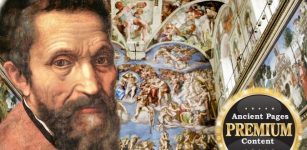 The Sistine Chapel Cypher – Secret Messages In The Art Of Michelangelo
Featured Stories | Mar 3, 2018
The Sistine Chapel Cypher – Secret Messages In The Art Of Michelangelo
Featured Stories | Mar 3, 2018 -
 Underground Hellenistic Necropolis With Tombs With Frescoes, Reliefs Unearthed In Naples, Italy
Archaeology | May 13, 2023
Underground Hellenistic Necropolis With Tombs With Frescoes, Reliefs Unearthed In Naples, Italy
Archaeology | May 13, 2023 -
 Mystery Of The Lost Underground City Of The Grand Canyon
Featured Stories | Nov 19, 2014
Mystery Of The Lost Underground City Of The Grand Canyon
Featured Stories | Nov 19, 2014 -
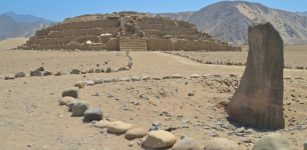 Sacred City Of Caral – Site Of The Oldest Known Civilization In The Americas
Civilizations | Aug 28, 2018
Sacred City Of Caral – Site Of The Oldest Known Civilization In The Americas
Civilizations | Aug 28, 2018 -
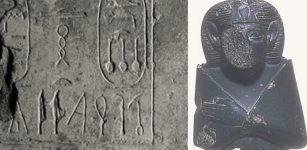 Sobekneferu: First Female Pharaoh In Ancient Egypt
Featured Stories | Mar 9, 2019
Sobekneferu: First Female Pharaoh In Ancient Egypt
Featured Stories | Mar 9, 2019 -
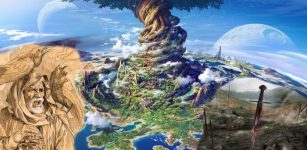 Yggdrasil: Eternal And Sacred Tree Of Life In Norse Mythology
Featured Stories | Sep 22, 2016
Yggdrasil: Eternal And Sacred Tree Of Life In Norse Mythology
Featured Stories | Sep 22, 2016 -
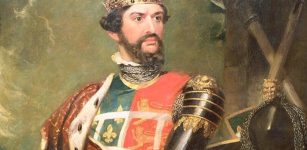 Illness And Death Of The Edward Of Woodstock ‘Black Prince’ Changed The Course Of English History
Archaeology | Dec 21, 2022
Illness And Death Of The Edward Of Woodstock ‘Black Prince’ Changed The Course Of English History
Archaeology | Dec 21, 2022 -
 Kalaripayattu – 3,000-Year-Old Indian Martial Art From Which Kung Fu And Karate Emerged
Ancient History Facts | Sep 6, 2020
Kalaripayattu – 3,000-Year-Old Indian Martial Art From Which Kung Fu And Karate Emerged
Ancient History Facts | Sep 6, 2020 -
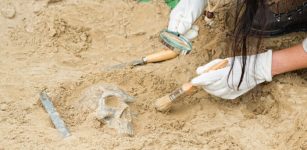 Discovery In Alabama Reveals Evidence Of Skull Surgery In North America Thousands Of Years Earlier Than Previously Thought
Archaeology | Apr 2, 2022
Discovery In Alabama Reveals Evidence Of Skull Surgery In North America Thousands Of Years Earlier Than Previously Thought
Archaeology | Apr 2, 2022 -
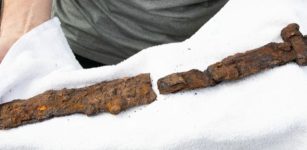 Man Finds A Viking Sword In His Garden – A Viking Grave Could Also Be Nearby – Scientists Say
Archaeology | Sep 2, 2022
Man Finds A Viking Sword In His Garden – A Viking Grave Could Also Be Nearby – Scientists Say
Archaeology | Sep 2, 2022 -
 Oldest Sea Reptile From Age Of Dinosaurs Found On A Remote Arctic Island
News | Apr 3, 2023
Oldest Sea Reptile From Age Of Dinosaurs Found On A Remote Arctic Island
News | Apr 3, 2023 -
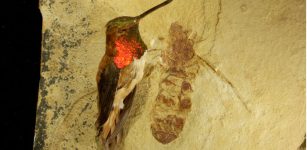 ‘Giant’ Ant Fossil Raises Questions About Ancient Arctic Migrations
Fossils | Mar 8, 2023
‘Giant’ Ant Fossil Raises Questions About Ancient Arctic Migrations
Fossils | Mar 8, 2023 -
 Strange Case Of The Italian Doppelganger – A Tragedy – Part 1
Featured Stories | Oct 14, 2019
Strange Case Of The Italian Doppelganger – A Tragedy – Part 1
Featured Stories | Oct 14, 2019 -
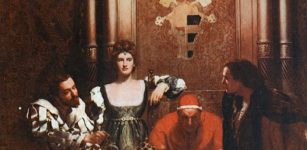 House Of Borgia – The Most Infamous Family Of Renaissance Italy
Featured Stories | Feb 28, 2019
House Of Borgia – The Most Infamous Family Of Renaissance Italy
Featured Stories | Feb 28, 2019 -
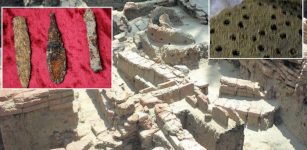 Keeladi, India: Ancient Residents Along Vaigai River Had Adopted Highly Progressive Technologies
Archaeology | Aug 28, 2020
Keeladi, India: Ancient Residents Along Vaigai River Had Adopted Highly Progressive Technologies
Archaeology | Aug 28, 2020 -
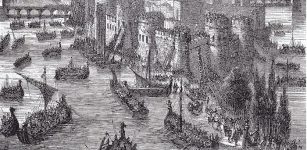 On This Day In History: ‘Sea King’ Ragnar Lodbrok Seizes Paris – On March 28, 845
News | Mar 28, 2017
On This Day In History: ‘Sea King’ Ragnar Lodbrok Seizes Paris – On March 28, 845
News | Mar 28, 2017 -
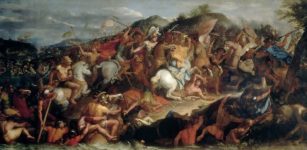 On This Day In History: Alexander The Great Defeats Darius III Of Persia In The Battle Of The Granicus On May 22, 334 B.C.
News | May 22, 2016
On This Day In History: Alexander The Great Defeats Darius III Of Persia In The Battle Of The Granicus On May 22, 334 B.C.
News | May 22, 2016 -
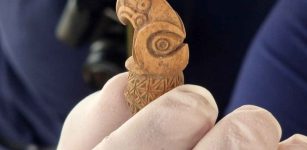 Rare 2,500-Year-Old Scythian Bone Sceptre Discovered In Bulgaria
Archaeology | Oct 3, 2023
Rare 2,500-Year-Old Scythian Bone Sceptre Discovered In Bulgaria
Archaeology | Oct 3, 2023 -
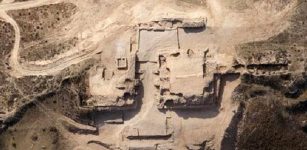 First Chinese Murals Unearthed In Shimao Ruins Are Over 4,000 Years Old
Archaeology | Aug 22, 2015
First Chinese Murals Unearthed In Shimao Ruins Are Over 4,000 Years Old
Archaeology | Aug 22, 2015 -
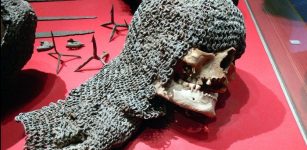 On This Day In History: Battle Of Visby, Gotland Was Fought – On July 27, 1361
News | Jul 27, 2016
On This Day In History: Battle Of Visby, Gotland Was Fought – On July 27, 1361
News | Jul 27, 2016


